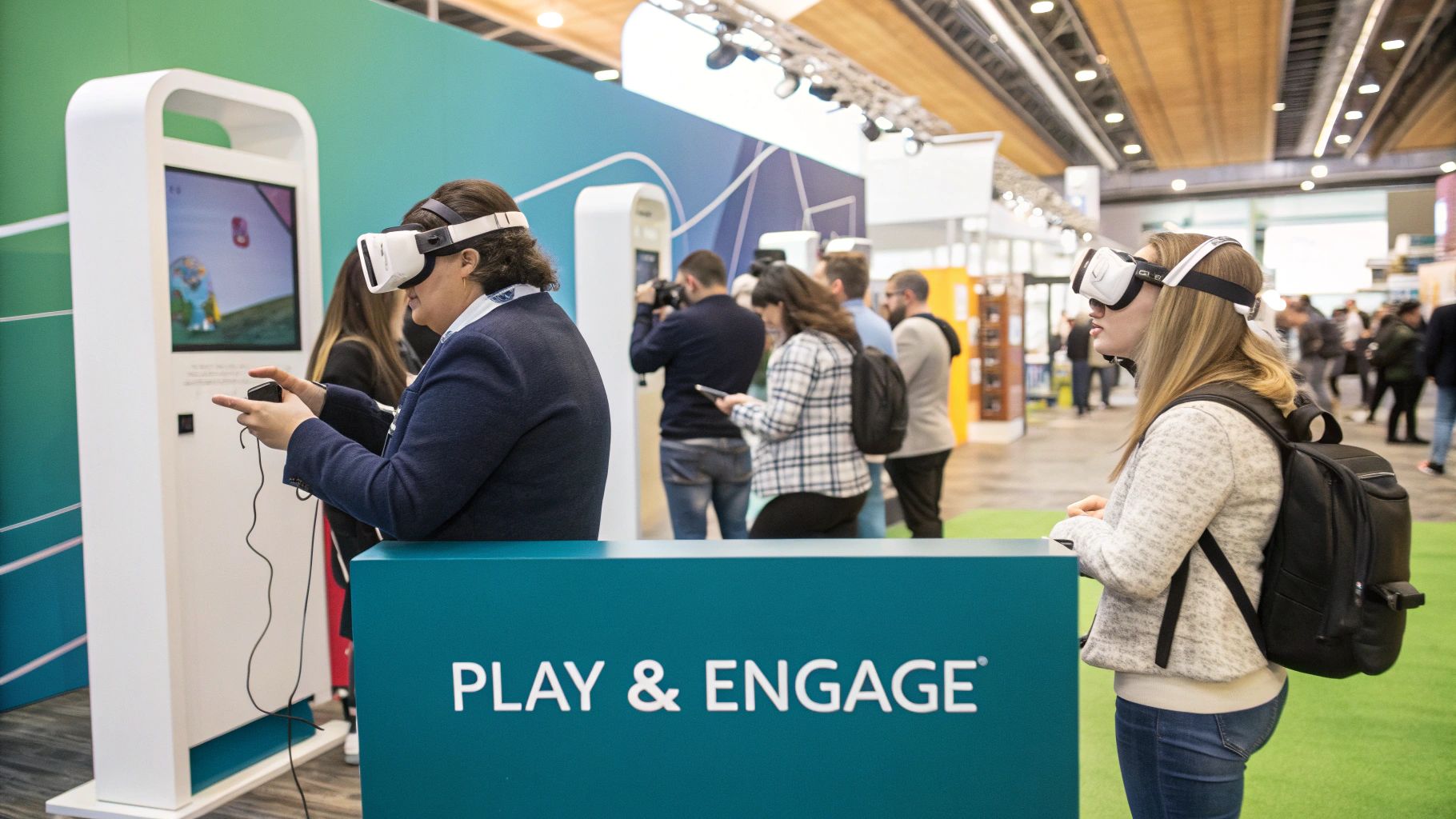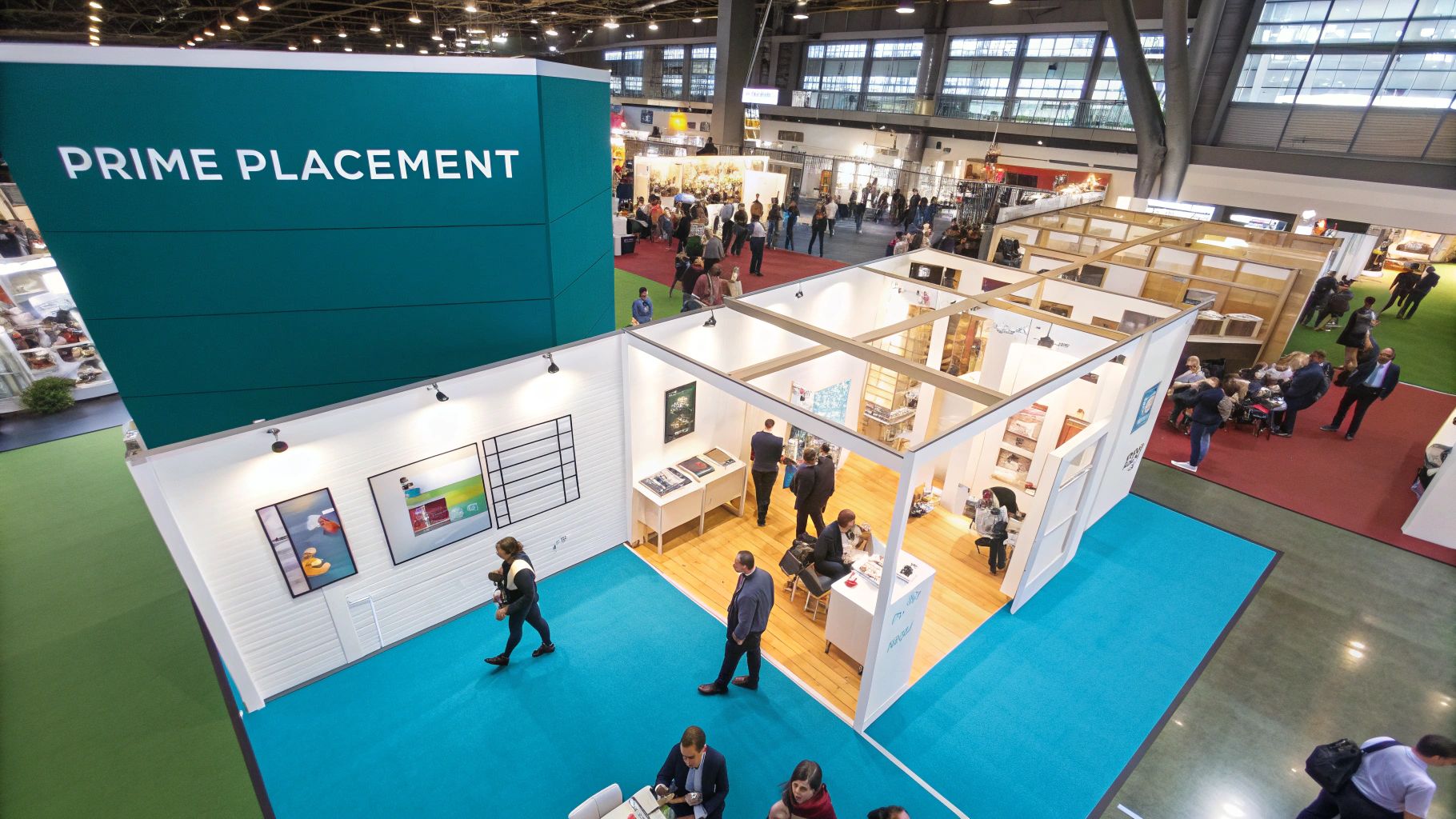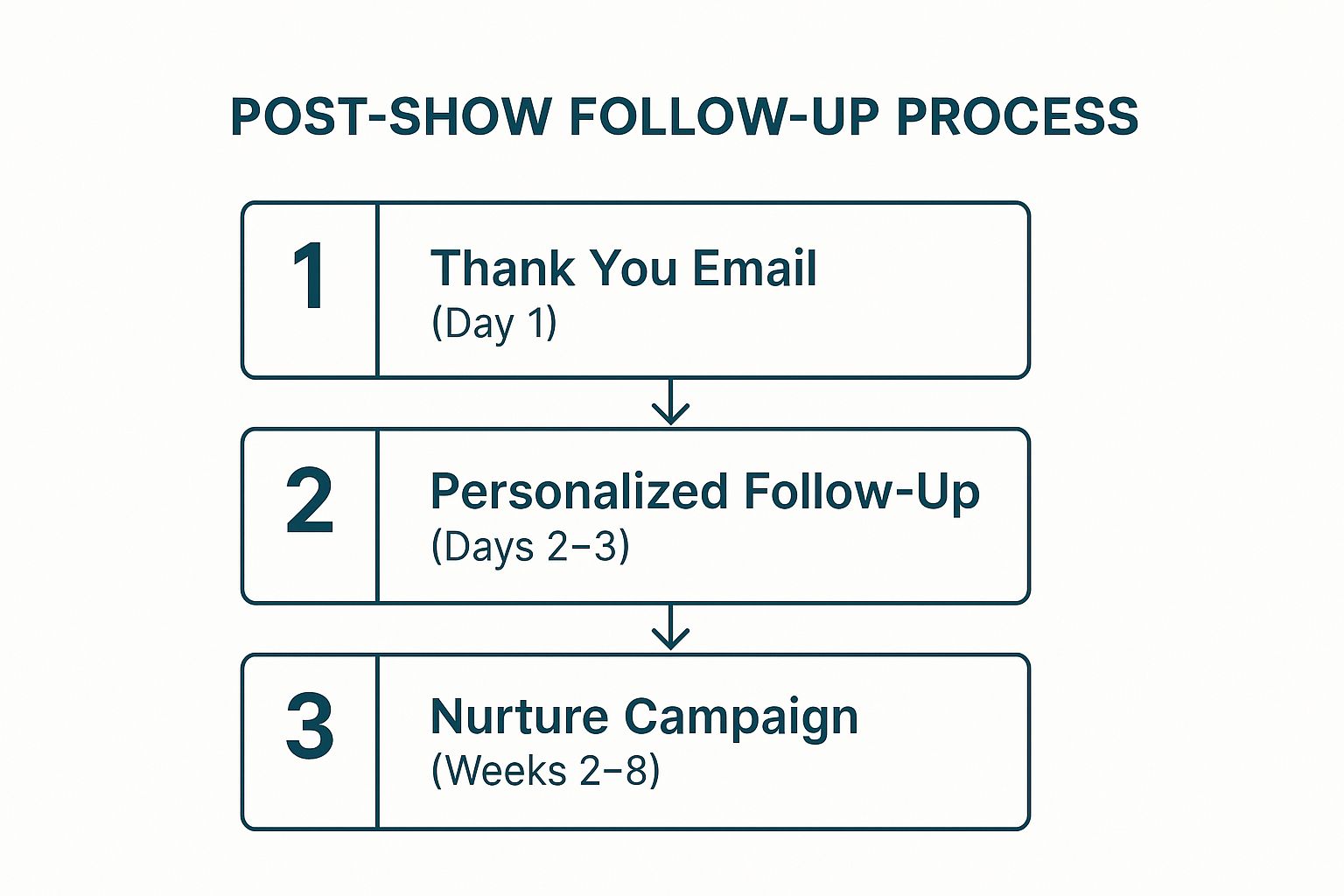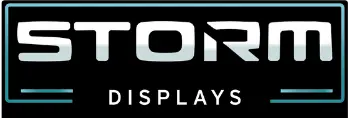You've secured the budget and booked the floor space. But as you look at the packed convention center map, a critical question emerges: How do you ensure your booth isn't just a costly blip on a crowded radar, but a magnet for high-value conversations and measurable returns? Many marketing managers and exhibit coordinators face this exact challenge—investing heavily in presence without a clear plan to convert that presence into profit. The difference between a forgotten exhibitor and a show-stealing brand lies in a comprehensive, multi-stage approach.
This guide moves past generic advice to provide a detailed playbook of 10 actionable trade show marketing strategies. We will cover the entire event lifecycle, from building pre-show buzz that guarantees foot traffic to implementing post-show nurture campaigns that turn handshakes into contracts. You will discover sophisticated tactics top brands use to dominate the show floor and drive tangible business growth.
The goal is to transform your trade show participation from an expensive line item into a predictable and powerful revenue engine. This guide provides the tactical framework needed to maximize your investment, demonstrating how strategic exhibit design, like a well-planned custom trade show booth, is just one component of a much larger, more profitable picture. Prepare to learn how to attract, engage, and convert your ideal customers long after the event concludes.
1. Pre-Show Marketing & Appointment Setting
Relying on foot traffic alone is one of the most common and costly trade show mistakes. A powerful pre-show marketing campaign transforms your booth from a passive exhibit into a must-visit destination. The goal is to build anticipation and fill your calendar with qualified appointments before the event even begins. This proactive approach ensures a steady stream of valuable conversations and maximizes your return on investment.
This strategy involves a multi-channel effort to connect with attendees in the weeks leading up to the show. By targeting registered attendee lists (when available), your own customer database, and relevant social media audiences, you create multiple touchpoints that build brand recognition and communicate your value proposition.
How to Implement a Pre-Show Campaign
A successful pre-show push is more than just a single email blast. It requires a coordinated sequence of communications designed to capture attention and drive action.
- Email Marketing Sequence: Create a 3-4 part email drip campaign. Start 4-6 weeks out with a general announcement of your participation, including your booth number. Follow up with emails highlighting specific problems you solve, new products you'll be launching, or exclusive show-only offers. Your final emails should be a direct call-to-action to book a meeting.
- Social Media Blitz: Use LinkedIn, X (formerly Twitter), and industry-specific platforms to share teasers of your booth design, introduce the team members attending, and run targeted ads aimed at individuals who follow the event or have relevant job titles. Use the official event hashtag to increase visibility.
- Direct Mail & Personal Outreach: For high-value prospects, a personalized approach works best. Send a small, creative direct mail piece with an invitation for a private demo. Have your sales team follow up with personal phone calls or LinkedIn messages to secure these crucial appointments.
Key Insight: The most effective trade show marketing strategies are those that start long before the event. Scheduling just 5-10 high-quality meetings in advance can guarantee your ROI, making any additional leads captured on the floor a bonus.
Ultimately, pre-show marketing puts you in control. Instead of hoping the right people find you, you ensure they have a compelling reason to seek you out, turning your exhibit into a scheduled, high-impact business development hub.
2. Interactive Booth Experiences & Gamification
In a crowded exhibit hall, a static booth can easily fade into the background. Interactive experiences and gamification are powerful strategies that transform your space from a passive display into an active, engaging destination. The goal is to stop attendees in their tracks, encourage participation, and create a memorable brand interaction that separates you from the competition. This hands-on approach increases dwell time and makes complex information digestible and fun.
By turning your booth into an experience, you invite attendees to do more than just listen; you invite them to participate. This shift from observer to participant dramatically improves information retention and generates genuine excitement.

How to Implement Interactive Experiences
A successful interactive element must be both engaging and relevant to your brand's message. It should serve as a natural conversation starter that bridges the gap between the activity and your value proposition. Even a small footprint can host a compelling activity; you can learn more about making your trade show booth more engaging on stormdisplays.com.
- Product-Centric Games: Develop a simple digital game or a hands-on challenge that highlights a key feature of your product. For instance, a software company could create a quick "bug-squashing" game, while a manufacturer might have a puzzle assembling a model of their product.
- VR/AR Demonstrations: Immerse attendees in a virtual world to showcase your product in action. A heavy machinery company, for example, could use a VR simulator to let users experience their equipment without bringing a multi-ton machine to the show floor.
- Interactive Touch-Walls & Quizzes: Use large touchscreens for attendees to explore case studies, product features, or take a short quiz related to industry pain points. Capture lead information to reveal their "score" or to enter them into a prize drawing.
Key Insight: The best trade show marketing strategies create a two-way dialogue. Gamification isn't just about entertainment; it's about educating attendees and qualifying leads in a way that feels organic and valuable to them, not like a sales pitch.
Ultimately, interactive experiences make your brand unforgettable. When attendees actively participate, they form a stronger connection with your company, ensuring your booth is the one they are still talking about long after the event ends.
3. Strategic Booth Design & Location Optimization
Your booth is more than just a physical space; it is the centerpiece of your event presence and a powerful communication tool. Strategic booth design and location optimization are about deliberately planning every aspect of your exhibit, from its position on the show floor to its visual and structural layout. The goal is to create an environment that maximizes visibility, attracts high-quality traffic, and facilitates meaningful engagement.
This strategy involves a thoughtful approach to space, aesthetics, and psychology. By selecting a high-traffic location and designing an open, inviting exhibit, you remove barriers to entry and make it easy for attendees to connect with your brand. A well-designed booth acts as a magnet, drawing people in from the aisles and ensuring your investment in the event pays off.

How to Implement Booth Design & Location Strategy
A powerful booth presence is a result of careful planning and execution, often starting many months before the show. It requires a balance of logistical planning and creative design to stand out in a crowded hall.
- Secure a Prime Location Early: Book your booth space 6 to 12 months in advance to get the best choice. Target high-traffic spots near main entrances, food courts, restrooms, or popular session rooms. An end-of-aisle or corner spot significantly increases your visibility and exposure.
- Design for Engagement & Flow: Your layout should be open and welcoming, with clear entry points and no intimidating barriers like a large table at the front. Adhere to the "3-second rule," ensuring visitors can understand who you are and what you do within three seconds of seeing your booth. Use bright, professional lighting and comfortable flooring to make your space inviting.
- Maximize Vertical Space & Visuals: In a sea of exhibitors, height equals visibility. Invest in tall structures or hanging signs that can be seen from across the event floor. Use bold, clear graphics and a concise core message. Dynamic elements like rotating displays or large video walls can effectively capture attention from a distance. For a deeper dive into creating a standout exhibit, you can find more insights into professional trade show booth design on stormdisplays.com.
Key Insight: The most effective trade show marketing strategies treat the booth as an active participant, not a passive backdrop. Designing your exhibit with 40% open space prevents a crowded feeling and encourages visitors to step in and explore, transforming passersby into engaged prospects.
Ultimately, your booth's design and location are fundamental to your success. A strategically placed and beautifully designed exhibit serves as a powerful beacon, guiding the right people to you and providing the perfect environment for business to happen.
4. Post-Show Follow-Up & Nurture Programs
The trade show doesn't end when the exhibit hall closes. In fact, the most crucial phase for ROI begins right after. A systematic post-show follow-up strategy is what separates successful exhibitors from those who leave money on the table. This is where you convert the conversations and scanned badges from the show floor into tangible business opportunities and long-term customer relationships.
This strategy involves a multi-channel, timed sequence of communications designed to maintain momentum and guide leads through the sales funnel. By categorizing leads and tailoring your outreach, you ensure that every interaction is relevant, timely, and moves the conversation forward. Abandoning leads after the event is a costly mistake; a structured nurture program ensures your investment pays off.
How to Implement a Post-Show Follow-Up System
An effective follow-up is not a single "thanks for stopping by" email. It's a persistent, value-driven campaign that demonstrates your commitment and professionalism.
- Speed and Segmentation: Time is critical. Contact your "hot" leads (those with immediate needs and purchase authority) within 24 hours. Warm leads should be contacted within 48-72 hours. Before the show ends, ensure every lead is assigned to a specific sales rep with clear next steps.
- Multi-Channel Outreach: Don't rely solely on email. A powerful follow-up sequence combines email, a personal phone call, and a LinkedIn connection request. For high-value prospects, a personalized video message or a small, thoughtful direct mail piece can make a significant impact.
- Context and Value: Personalize your outreach by referencing specific conversations you had at your booth. Mention the challenges they discussed or a product they showed interest in. Fulfill any promises you made, such as sending a case study, a demo link, or a custom quote.
The following infographic illustrates the ideal timeline for a structured post-show follow-up campaign.

This process ensures that momentum is captured immediately and engagement is maintained over the long term, moving prospects methodically through the buyer's journey.
Key Insight: Many companies find that over 70% of trade show leads are never properly followed up on. Implementing structured trade show marketing strategies for post-show nurturing gives you a massive competitive advantage, converting connections into revenue while others let them go cold.
Ultimately, a disciplined follow-up and nurture program is the final, essential step that validates your entire trade show investment. It ensures that the effort put into designing a stunning exhibit and engaging attendees translates directly into measurable business results.
From Strategy to Success: Building Your Winning Exhibit
The trade show floor is a dynamic, competitive arena where opportunity is measured in seconds. As we've explored, success is no longer about simply showing up; it's about executing a multi-faceted plan that engages attendees at every touchpoint. From the initial pre-show buzz to the crucial post-show follow-up, each of these trade show marketing strategies serves as a vital component in a much larger machine. Your goal is to build a cohesive system where every element works in harmony, transforming your exhibit from a passive space into a powerful engine for lead generation and brand building.
The common thread weaving through all these tactics is a shift from broadcasting to engaging. It's about moving away from the "if you build it, they will come" mentality and actively creating a compelling, valuable, and memorable experience for every person who steps into your booth. This is where strategy and structure converge. An exceptional interactive game or a well-planned pre-show campaign will only reach its full potential when supported by a physical environment that commands attention and facilitates interaction.
To truly master the trade show environment, you must see these strategies not as a checklist, but as an integrated ecosystem. Think about how these key pillars support one another:
- Pre-Show Planning & Post-Show Nurturing: These are the bookends of your entire campaign. Your pre-show marketing builds anticipation and schedules key meetings, while your post-show follow-up converts interest into revenue. Neglecting either one leaves significant value on the table.
- Booth Experience & Design: Your physical exhibit is the stage where all the action happens. Strategic booth design isn't just about aesthetics; it's about creating a frictionless journey for the attendee. It should effortlessly guide them toward your interactive elements, meeting spaces, and lead capture stations. A well-designed booth amplifies your message and makes your marketing efforts more effective.
- Engagement & Lead Capture: Gamification, educational content, and personalized meetings are the tools you use to draw people in and hold their attention. But engagement without efficient data capture is a missed opportunity. Your lead qualification system must be seamless, allowing your team to quickly gather information without disrupting the positive experience you've created.
Ultimately, the most successful trade show marketing strategies are those built on a foundation of intentionality. They require a deep understanding of your target audience, clear objectives, and the right tools to bring your vision to life. The true value lies in creating a holistic journey that begins long before the event doors open and continues well after they close, building lasting relationships and driving measurable business growth. Your exhibit is the physical manifestation of this entire effort, and its design and functionality are critical to your overall success.
A brilliant strategy deserves a show-stopping stage. The right exhibit design is the foundation that brings your marketing plan to life, creating an environment that captivates attendees and empowers your team. Let Storm Displays help you build an exhibit that not only looks incredible but also functions as a high-performance marketing tool. Explore our portfolio of award-winning trade show displays and request a quote today to start planning your most successful event yet.

